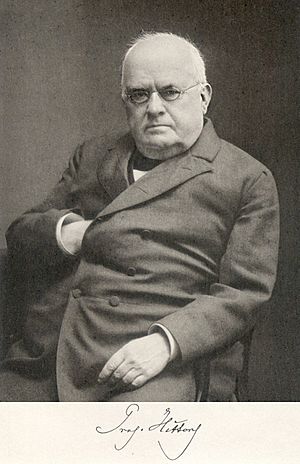Johann Wilhelm Hittorf facts for kids
Quick facts for kids
Johann Wilhelm Hittorf
|
|
|---|---|

Johann Wilhelm Hittorf c. 1904
|
|
| Born | 27 March 1824 Bonn, Rhine Province, Kingdom of Prussia
|
| Died | 28 November 1914 (aged 90) Münster, Province of Westphalia, German Empire
|
| Nationality | German |
| Known for | Crookes–Hittorf tube Hittorf's metallic phosphorus Ion transport number |
| Awards | Hughes Medal (1903) |
| Scientific career | |
| Fields | Physics |
Johann Wilhelm Hittorf (March 27, 1824 – November 28, 1914) was a German physicist. He was born in Bonn and passed away in Münster, Germany.
Hittorf made important discoveries about how electricity moves through liquids and gases. His work helped us understand things like batteries and X-rays.
Contents
Understanding Electric Flow
Hittorf was the first to figure out how much electricity charged particles, called ions, could carry. Ions are atoms or molecules that have an electric charge. This was a big step in understanding how chemical reactions involving electricity work.
He created a way to measure these "ion transport numbers". This showed how different ions move at different speeds when electricity flows through a liquid. He published his findings on how ions move in 1869.
Discovering Cathode Rays
Hittorf also studied special vacuum tubes. These are glass tubes with most of the air removed. He saw energy rays coming from the negative side (called the electrode) inside these tubes. When these rays hit the glass walls, they made the glass glow.
In 1876, another scientist named Eugen Goldstein named these glowing rays "cathode rays". Hittorf's observations were very important for understanding these rays.
How Cathode Rays Glow
In 1869, Hittorf found that cathode rays glowed in different colors. The color depended on the type of gas left in the tube and how much pressure was inside. He also noticed that if he put an object between the cathode and the glowing part of the tube, the object's shadow would appear.
Early Research and Impact
Hittorf's early studies looked at different forms of elements like phosphorus and selenium. These different forms are called allotropes.
His work on cathode rays was a key step towards developing X-rays. It also helped create cathode ray tubes, which were used in old televisions and computer monitors. Measuring how electricity moved in a vacuum tube was also important for inventing the vacuum tube diode, a basic electronic component.
Hittorf worked as a professor of physics and chemistry at the University of Münster. He was also the director of the laboratories there from 1879 to 1889.
See also
 In Spanish: Johann Wilhelm Hittorf para niños
In Spanish: Johann Wilhelm Hittorf para niños

